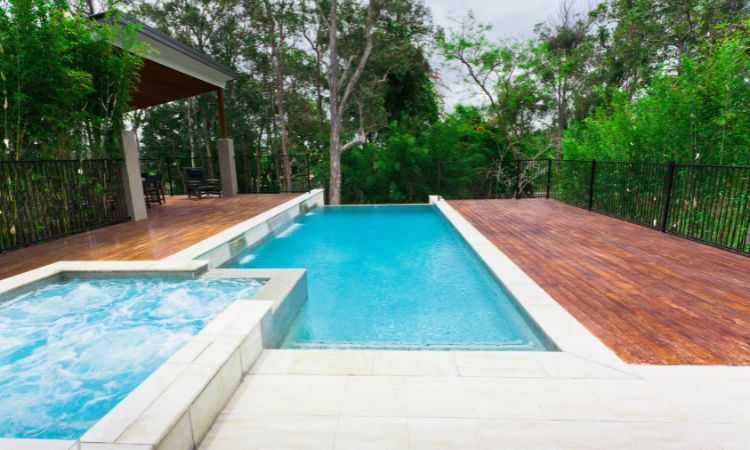The global swimming pool construction market size is expected to grow in the forecast period of 2025-2033 at a CAGR of 3%. This growth is driven by rising disposable incomes, an increased focus on wellness and leisure, and the demand for luxury residential and commercial amenities. With an expanding middle class in developing economies, and a growing interest in private and communal recreational spaces, swimming pools have become an integral feature of both residential homes and commercial properties like hotels, resorts, and wellness centers. This blog explores the key factors driving the market, key materials used in construction, popular pool types, market dynamics, and regional trends shaping the future of swimming pool construction.
Market Overview
Swimming pools are no longer seen as just recreational spaces; they have become symbols of luxury, leisure, and health. As a result, demand for residential and commercial swimming pool construction has surged. Modern pool construction has evolved beyond traditional designs, incorporating innovative materials, energy-efficient solutions, and high-tech features that cater to eco-conscious and luxury-minded consumers alike. The market is expanding globally, with a steady increase in the demand for both in-ground and above-ground pools.
The growth of the swimming pool construction market is also fueled by the increasing focus on wellness, which has made people more inclined to invest in home amenities that promote relaxation and physical fitness. Additionally, the tourism and hospitality sectors, particularly hotels and resorts, continue to drive demand for large-scale, high-end pools designed to cater to affluent customers.
Market Segmentation
By Material
The materials used for swimming pool construction play a crucial role in determining the pool’s durability, aesthetic appeal, and cost. The major materials used in the construction of swimming pools include concrete, fiberglass, vinyl liner, steel frame, and other niche materials.
Concrete
Concrete remains one of the most popular materials for swimming pool construction due to its strength, flexibility, and durability. Concrete pools are highly customizable, which makes them ideal for luxury and large-scale pool projects. The concrete market is particularly robust in the residential segment, where homeowners demand customized designs and a wide range of finishes. Moreover, the longevity and low maintenance required for concrete pools make them a preferred choice for high-end commercial projects, including hotels and resorts.
Fiberglass
Fiberglass pools have been gaining popularity due to their faster installation time and lower maintenance requirements compared to concrete pools. These pools are pre-manufactured, making them easier and quicker to install, which appeals to homeowners looking for cost-effective and hassle-free options. The fiberglass pool market has seen steady growth in the residential sector, especially for smaller or more compact pools. They are also highly durable and resistant to algae growth, which further boosts their demand.
Vinyl Liner
Vinyl liner pools are one of the most affordable options for both residential and small commercial pool construction. The material offers flexibility in terms of design and is easier to maintain compared to other materials. While vinyl liner pools may not have the same longevity as concrete or fiberglass pools, they remain a popular choice in markets that are more cost-sensitive. Additionally, advances in vinyl liner technology have enhanced their durability, making them a viable option for mid-range residential projects.
Steel Frame
Steel frame pools combine the strength of steel with the flexibility of other materials such as vinyl liner or fiberglass. Steel frame pools are easy to install, durable, and less expensive compared to concrete pools. They are ideal for both residential and small commercial applications where cost-effectiveness and ease of installation are important. This segment is expected to see a steady rise in demand due to growing interest in affordable yet sturdy pool options.
Other Materials (Hybrid, Natural Pools, etc.)
As sustainability becomes an increasing priority, alternative pool types, such as natural pools and hybrid pool systems, are gaining traction. These pools utilize environmentally friendly materials and systems, such as bio-filtration, natural swimming environments, and eco-friendly liners. The growing trend of eco-conscious consumerism is expected to drive the demand for these alternative solutions, particularly in regions with strict environmental regulations or in markets driven by luxury and sustainability.
By Type
Swimming pools can generally be categorized into two main types: in-ground and above-ground pools.
Above Ground Pools
Above-ground pools are generally more affordable and easier to install compared to in-ground pools. They are particularly popular in residential markets where consumers are seeking cost-effective solutions for smaller spaces. These pools can be either temporary or permanent fixtures, depending on the installation type. The popularity of above-ground pools has surged due to their low maintenance and installation costs. With improvements in design and aesthetics, these pools are becoming more appealing to consumers seeking a balance of quality and affordability.
In-Ground Pools
In-ground pools represent the luxury segment of the swimming pool construction market. These pools are permanent fixtures that can be customized according to the specific requirements of the property owner. The demand for in-ground pools is driven by the increasing demand for residential luxury, as well as high-end commercial spaces such as hotels, resorts, and fitness centers. In-ground pools can be designed using various materials such as concrete, fiberglass, or vinyl liner, offering versatility in terms of aesthetics and function. This segment is expected to witness significant growth, especially in affluent markets and regions with hot climates.
By End User
Swimming pool construction caters to both residential and non-residential end users, each with distinct needs and preferences.
Residential
The residential segment is the largest and fastest-growing market for swimming pool construction. Homeowners are increasingly looking to enhance their lifestyle by incorporating swimming pools into their properties. This trend is largely driven by factors such as rising disposable incomes, a growing interest in home wellness and fitness, and the desire for outdoor leisure spaces. Additionally, the trend towards “staycations”—vacations taken at home—has further boosted the demand for residential pools.
Non-Residential
The non-residential segment includes commercial properties such as hotels, resorts, fitness centers, public pools, and wellness centers. The growing tourism and hospitality industry is a key driver of pool demand in this sector. High-end resorts and hotels, in particular, are investing in state-of-the-art pool facilities as a means to attract customers and enhance their brand appeal. Public swimming pools and municipal water parks are also popular in urban areas, where they serve as community recreational spaces.
Regional Analysis
North America
The North American market, particularly in the United States and Canada, remains a dominant player in the swimming pool construction industry. The demand for both in-ground and above-ground pools in residential homes is significant, with consumers opting for luxury features, energy-efficient systems, and custom designs. Additionally, the commercial sector in North America, particularly in resorts, hotels, and fitness centers, continues to drive the demand for high-end pool solutions.
Europe
In Europe, demand for swimming pools is growing, especially in countries with a warm climate such as Spain, Italy, and France. Luxury pools are particularly popular in residential estates, while the tourism and hospitality industry drives demand for large-scale commercial pools. Furthermore, eco-conscious design and sustainability trends are gaining ground in the region, with a growing number of consumers and businesses opting for energy-efficient and environmentally friendly pool solutions.
Asia-Pacific
The Asia-Pacific region is experiencing rapid urbanization and rising disposable incomes, particularly in countries like China, India, and Japan. As the middle class expands and consumer preferences shift toward luxury and wellness, the demand for swimming pools in both residential and commercial markets is growing. Additionally, countries in the region with tropical or subtropical climates are likely to see sustained demand for pools.
Latin America
In Latin America, the demand for swimming pools is growing, particularly in countries like Brazil, Mexico, and Argentina. The rising interest in luxury real estate, especially in coastal areas, is driving the residential pool market. Additionally, the tourism and hospitality sectors in countries like Brazil and Mexico are contributing to the rise in commercial pool construction.
Middle East & Africa
In the Middle East, countries such as the UAE, Saudi Arabia, and Qatar are seeing strong demand for luxury in-ground pools, particularly in the hospitality sector. The extreme heat in the region makes swimming pools an attractive feature for hotels and resorts. Additionally, the growing interest in wellness and fitness has led to an increase in the construction of pools in residential properties. In Africa, demand for pools is growing in urban areas and high-income residential segments.
Market Dynamics
Key Drivers
- Rising Disposable Income: Growing wealth and a desire for luxury living are driving the demand for high-end pools, particularly in residential and commercial properties.
- Increased Focus on Wellness: With the increasing importance of fitness and leisure, more homeowners are opting to install swimming pools to enhance their lifestyle.
- Tourism and Hospitality Growth: The expanding tourism industry, particularly in luxury resorts, has spurred demand for sophisticated pool designs and large-scale installations.
- Technological Advancements: Innovations in pool technologies, such as energy-efficient systems, automated maintenance, and eco-friendly solutions, are encouraging more consumers to invest in pools.
Restraints
- High Initial Investment: The cost of installing swimming pools, particularly in-ground pools, can be prohibitive for some consumers, limiting market expansion in price-sensitive segments.
- Maintenance Costs: The ongoing maintenance and operational costs associated with swimming pools can deter potential buyers, especially in areas with high energy or water costs.
Opportunities
- Eco-friendly Pool Solutions: There is increasing demand for energy-efficient, sustainable pool designs that use less water and energy.
- Smart Pool Technology: Pool automation, including smart pumps, water quality monitoring, and lighting systems, offers new opportunities for innovation in the pool construction market.









